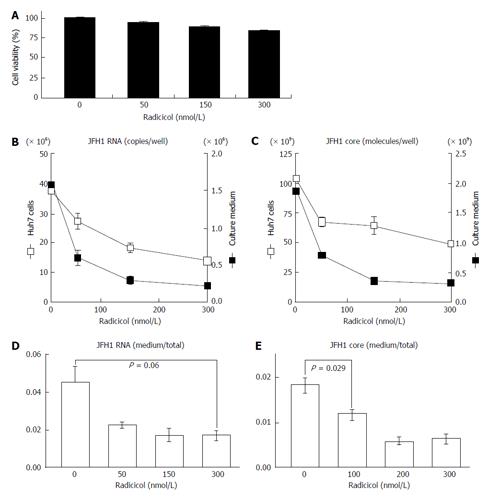Copyright
©The Author(s) 2016.
World J Hepatol. Feb 18, 2016; 8(5): 282-290
Published online Feb 18, 2016. doi: 10.4254/wjh.v8.i5.282
Published online Feb 18, 2016. doi: 10.4254/wjh.v8.i5.282
Figure 1 Radicicol affects the relative level of hepatitis C virus (core and hepatitis C virus RNA) produced from the JFH1/cell culture-derived hepatitis C virus system of Huh-7 cells.
A: After the cells were treated with radicicol (at final concentration of 0, 50, 150 and 300 nmol/L) for 12 h, the culture medium was replaced with fresh medium containing the same radicicol levels, and the HCV RNA and core levels released into the medium for the next 24 h and produced within cells were determined as described in the text. The cytotoxic effects of the treatment of radicicol on HCVcc Huh-7 cells were examined as described in the text; B and C: The levels of HCV RNA (B) and core (C) in the HCVcc Huh-7 cells (open squares) and the culture medium (filled squares) were quantified. The scales on the left sides (B and C) indicate the scales for the HCV RNA and the core in the Huh-7 cells. The scales on the right sides (B and C) indicate the scales for the HCV RNA and the core in the culture medium; D: The ratios of HCV RNA in the medium to the total HCV RNA (the sum of HCV RNA in the medium and in the cells) are shown; E: The ratios of the core in the medium to the total core (the sum of the core in the medium and in the cells) are shown. The data represent the mean values (± SEM) of the results from three independent experiments. HCV: Hepatitis C virus; HCVcc: Cell culture-derived HCV.
- Citation: Kubota N, Nomoto M, Hwang GW, Watanabe T, Kohara M, Wakita T, Naganuma A, Kuge S. Hepatitis C virus inhibitor synergism suggests multistep interactions between heat-shock protein 90 and hepatitis C virus replication. World J Hepatol 2016; 8(5): 282-290
- URL: https://www.wjgnet.com/1948-5182/full/v8/i5/282.htm
- DOI: https://dx.doi.org/10.4254/wjh.v8.i5.282









